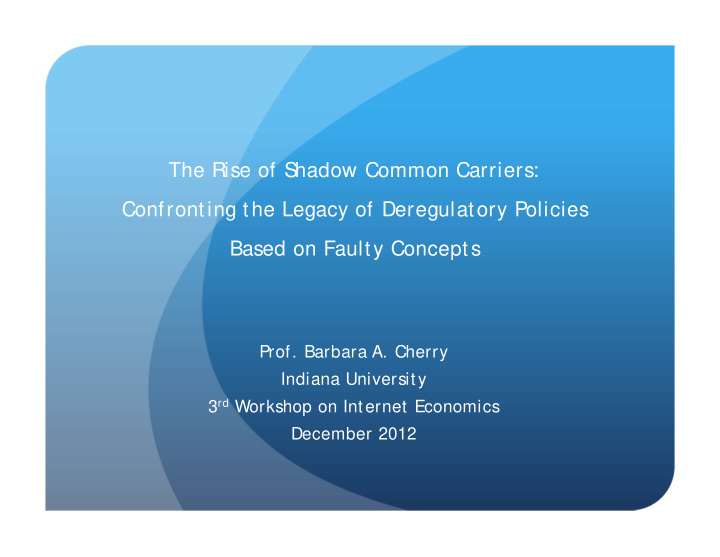



The Rise of S hadow Common Carriers: Confronting the Legacy of Deregulatory Policies Based on Faulty Concepts Prof. Barbara A. Cherry Indiana University 3 rd Workshop on Internet Economics December 2012
2 Overview We need to look to other industries for insights as to the consequences of deregulatory policies that create shadow versions of regulated activities. Lessons can be learned from deregulatory banking policies, under which shadow banking activities negatively affected certain classes of individuals and created or exacerbated systemic risks for the financial sector. Deregulatory policies have created shadow common carriers, and created/ exacerbated systemic risks among critical infrastructures that are compounded by a less adaptability U.S . policymaking system .
3 What Are S hadow Activities? “ S hadow activities” refers to those actions that meet the definition of the “ activity” but fail to be recognized or regulated by public or government instructions as such. Why do shadow activities develop? To avoid regulatory rules, either legally or illegally. As a matter of law through deregulatory policies, dismantling prior regulation or prohibiting regulation of new activities As unintended consequences of deregulatory policies.
4 What is S ystemic Risk? S ystemic risk refers to risk of breakdowns in an entire system, as opposed to individual parts or components, and is evidenced by comovements (correlation) among all or most parts. Concepts of systemic risk include Macro shocks to the entire system (with unspecified contagion). Microlevel events and transmission of shock and potential spillover from one unit to another. Chain reactions (direct causation) Common shocks (correlation without direct causation)
5 How Have S ystemic Risks Grown in Financial Markets? There has been a rise in systemic risk --both new from innovation and recurring from deregulatory policies. Problems posed by new complex, off-balance sheet activities and financial instruments. Dismantling of prior rules that had been imposed to promote financial stability. The rise in systemic risk has changed the emergent properties of the financial systems in the U.S . and internationally. Financial markets have become more dynamic and unstable.
6 The Creation of Shadow Common Carriage And the Growth of Systemic Risks
7 What is (Original) Common Carriage Under the Common Law? Duties imposed under tort law are relational norms that enj oin persons from acting toward certain other persons in certain ways. Under common law, common carriers bear the tort obligations: To serve upon reasonable request without unreasonable discrimination at j ust and reasonable prices and with adequate care. Common carriers bear these obligations merely based on their economic relationship with customers (i.e. status), independent of any requirement or finding of monopoly or market power .
8 Why Did S tatutory Common Carriage Develop? As explained in the Cullom Report of 1886, federal statutory regime of common carriage developed because The common law remedies were inadequate; S tates lacked j urisdiction over interstate commerce; Reliance on competition was insufficient to protect customers. Congress enacted the Interstate Commerce Act of 1887 To regulate railroads through ICC agency oversight; Was amended in 1910 to apply to telegraphy and telephony; Provided the framework for Title II of the Communications Act of 1934 (creating the FCC).
9 How Did Common Carriage Initially Apply to Information S ervices? The FCC developed a classification scheme through the Computer Inquiry proceedings. Enhanced service is offered over transmission facilities employing computer processing applications that act on the subscriber’s transmitted information. Classified as not common carriage. But has a separable telecommunications service component, i.e. basic service, classified as common carriage. Basic service is the transmission capability over a communications path. Classified as a Title II common carriage service to endusers, and available to ES Ps on a Title II common carriage basis per FCC rule.
10 … And to DS L? After enactment of the Telecommunications Act of 1996, the FCC applied the same framework to DS L in 1998. DS L is a Title II common carriage service to endusers. The telecommunications component of DS L must be available on a Title II common carriage basis to IS Ps per FCC rule.
11 What was the Radical Policy Departure for Broadband S ervices? Classification of broadband Internet access services as title I information services FCC Cable Modem Declaratory Ruling (2002) FCC Wireline Broadband Order (2005) These rulings have created shadow common carriers for broadband services . VOIP is also shadow common carriage where the FCC has failed to classify such service.
12 How Does the Growth of S hadow Common Carriers Create S ystemic Risk? (1) Disrupts the legal interrelationships among industry- specific and general business legal regimes. (2) Creates or exacerbates problematic, inter-infrastructure effects. (a) Within the communications sector. Unavailability of any common carriage communications service. (b) With the U.S . Postal S ervice (US PS ) system. Threatens financial viability of US PS . (c) With the transportation and electricity sectors. Cascading failures among infrastructures.
13 How is S ystemic Risk Compounded By A Less Adaptable Policymaking S ystem? Deregulatory policies create mechanisms of entrenchment that make the U.S . policymaking system less adaptable. (1) Through policies of federal preemption. Which blocks state policy experimentation. (2) Through recognition of constitutional rights of communications providers (particularly Free S peech). Which blocks federal policy experimentation. (3) Through combinatorial effects with subsequent legal developments in other bodies of law. E.g. Citizens United v. FEC further elevates free speech rights of corporate broadband providers to block federal policy experimentation.
14 Concluding Comments Growth of shadow common carriers creates or exacerbates systemic risks through creation of legal gaps among bodies of law as well as negative inter-infrastructure effects. S ystemic risk is further compounded by mechanisms of entrenchment - enabled by deregulatory policies - that block policy experimentation and render the U.S . policymaking system less adaptable to respond.
Recommend
More recommend